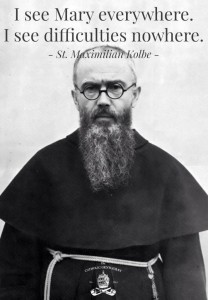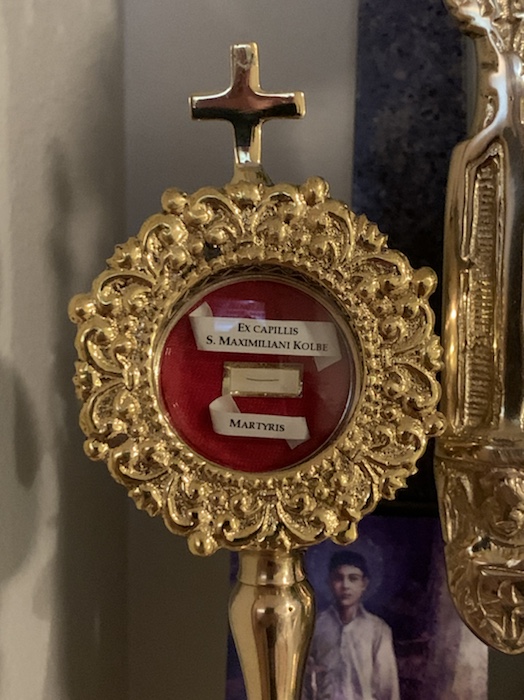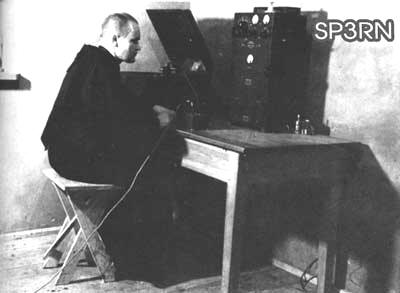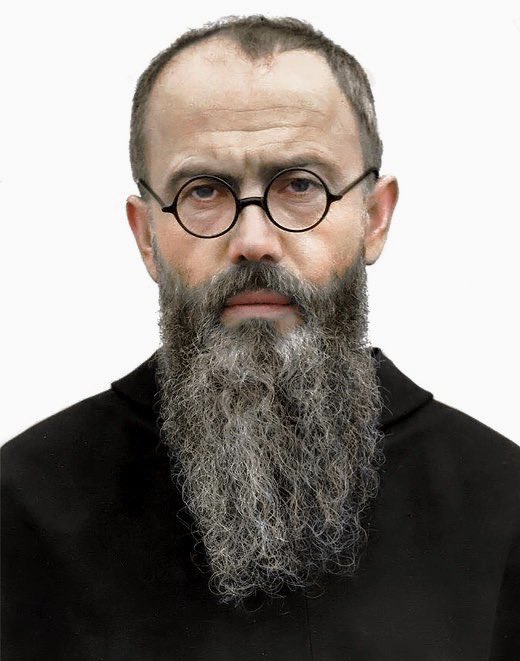 Today, 14 August, is the Vigil of the Assumption (purple). It is also the Feast of St. Maximilian Kolbe (red), a Franciscan priest put to death at Auschwitz.
Today, 14 August, is the Vigil of the Assumption (purple). It is also the Feast of St. Maximilian Kolbe (red), a Franciscan priest put to death at Auschwitz.
St. Maximilian Kolbe, has a special relevance for Catholic media.
Today, dear readers, say a prayer to him, asking his intercession with God for the conversion of catholics who use the media to confuse the faithful and to distort the teachings of the Church. Pray especially for the conversion of the staff of the National Schismatic Reporter (aka Fishwrap), RU-486 (aka The Tablet), Jesuit-run Amerika, as well as several individuals who prate with tweets that distort the Faith or some aspect of the faith or morals.
Remember the prayer to St. Joseph for the Conversion of the National catholic Reporter which I posted HERE.
These “catholic” outlets must be converted or, like the priests of Baal, they must fail and fail spectacularly.
Also, please ask St. Maximilian to intercede, asking God to keep those who are dedicated to making Christ and His Church known and loved in their fullness faithful, charitable and courageous.

My 1st Class relic of St. Maximillian Kolbe
St. Maximillian was beatified by Paul IV in 1971 as a confessor (he lived a life of heroic virtue) and canonized by John Paul II in 1982 as a martyr (killed because of the Faith).
The two categories are not exclusive. As a matter of fact, in the moment of martyrdom, the virtues are perfected in a person.
However, the use of two categories does raise a question. Which was it? Heroic virtue? Martyrdom? In fact, he probably wasn’t killed by the Nazis because of the Faith, or his priesthood: he offered to take the place of another prisoner. His choice led to his death. He offered his life, though it may not have been martyrdom, in the strict sense.
(His choice led to his death. I’m reminded of the situation in Chicago with Cupich and the Institute. He forced them into a corner where they had to sign something that they couldn’t possible sign without betraying their identity and the people they serve. Then when he took away their ability to say Mass publicly his spox said “It was their choice!” Right.. just like it was St. Thomas More’s choice… St. John Fisher’s choice…. I digress.)
There is, in the paths to beatification, both the way of heroic virtue and martyrdom, but also now, since fairly recent, what is called oblatio vitae.
I am not one for innovations, but this seems good to me.
The criteria for oblatio vitae include:
a) the free and willing offering of life and heroic acceptance propter caritatem of certain death and in a brief time limit;
b) the exercise, at least in an ordinary degree, of the Christian virtues before the offering of life and, thereafter, until death.
Again, this path describes a person who has during life, been living a virtuous life, but in at least an ordinary rather than extraordinary and heroic way. Out of true charity (properly understood as sacrificial love of God and neighbor exemplifying Christ’s own sacrificial love) he performs some act which results in death in a short period of time and because of the act performed.
Hence, St. Maximilian, living of life of virtue (he was beatified under that rubric), by his offering (not necessary because the Nazi’s chose him because he was a Catholic priest) died as a result.
Hence, Ven. Vince Capodanno, who lived a virtuous life, was killed when trying to help a wounded Marine. The enemy didn’t shoot him because he was a priest, he was just another target.
Hence, St. Gianna Beretta Molla, who lived a virtuous life. She died offering her life for the life of her unborn child. She made a choice in favor of the life of another that resulted in her death.
Of great importance in this new path is the necessity that it be shown that the person lived a virtuous life before the act of charity that lead to death, and that the act that resulted in death was performed from true charity properly understood.
After that, just as in the cases of martyrdom and of the life of heroic virtue, there must also be a reputation of sanctity and a miracle for beatification, etc., as in the other two paths.
I have a detailed post about this HERE.
Finally, I remind you hams out there that St. Maximilian, was also a ham.
SP3RN!
In 1930, Franciscan Father Maksymilian Maria Kolbe left Poland for Japan, China and India where he organized monasteries. When in Japan, Father Kolbe got acquainted with a network of small broadcasting radio stations. To supplement a large number of religious periodicals that he was publishing in Poland and abroad at that time, he decided to start a radio station as a new medium. In 1930, he applied for a radio broadcasting license in Poland. However, only the Polish Radio Warsaw (1925) and a military radio station held exclusive radio licenses at that time. Radio receivers were allowed to be owned by permission early in 1924.
[…]
More HERE.

Also, Zednet exists on the Yaesu System Fusion (Wires-X) “room” 28598, which is cross-linked to Brandmeister (BM) DMR worldwide talkgroup 31429, which essentially gives world-wide multi-mode access to a common ham radio network. It is a bit “dormant” now. I’d like to fire it up again.
Thanks for remembering St. Max. He is an important man for our sad times, especially as the normal modes of communication are being co-opted by the forces of evil.
A great colorized photo of St. Max.



































We miss the Zednet! Please restart it soon! W2JPG
So by such standards, would Sydney Carton’s self-sacrifice in A Tale of Two Cities not earn him heaven, since his life up to that point had been one of dissipation instead of virtue?
I think his character has in many ways been seen as a good literary example of this sort of generosity and its rewards, for after all, Christ himself said, “Greater love than this no man hath, that a man lay down his life for his friends.” Surely his nobility has inspired many over the centuries…
Perhaps we may not canonize a Sydney Carton in real life, wanting any canonized saint to better exemplify the virtues, but I would think that by that act alone, he, like Dismas the good thief, should surely have stolen heaven…? And the canon of saints gives hope to the fallen by including quite a few who amended their lives in the 11th hour…?
No challenge to what you have stated (or what the Church has delineated) intended, but I find this a worthy discussion… :)